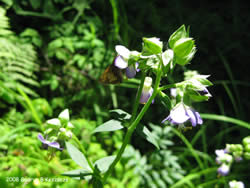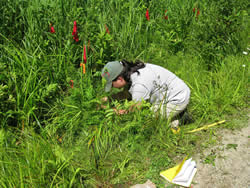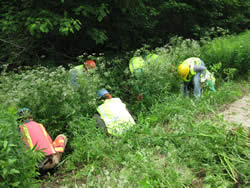Understanding and Conserving Appalachian Jacob's Ladder (Polemonium vanbruntiae)
 Appalachian Jacob's ladder in bloom, being visited by a butterfly. Photo by Gudrun B. Keszocze.
Appalachian Jacob's ladder in bloom, being visited by a butterfly. Photo by Gudrun B. Keszocze.
 Researcher Laura Hill from the University of Vermont establishes plots for an administrative study of Appalachian Jacob's ladder. Photo by Gudrun B. Keszocze.
Researcher Laura Hill from the University of Vermont establishes plots for an administrative study of Appalachian Jacob's ladder. Photo by Gudrun B. Keszocze.
 Volunteers and staff pull the non-native invasive plant wild chervil from roadside ditches near Appalachian Jacob's ladder. Photo by Gudrun B. Keszocze.
Volunteers and staff pull the non-native invasive plant wild chervil from roadside ditches near Appalachian Jacob's ladder. Photo by Gudrun B. Keszocze.
Appalachian Jacob's ladder (Polemonium vanbruntiae) is an herbaceous perennial in the phlox family (Polemoniaceae). Although sometimes cultivated, in the wild it is rare range-wide. Known only from northeastern North America, it has a global status of G3G4 (indicating it is unclear whether it is at risk of extinction), and is on the Regional Forester Sensitive Species List for the Green Mountain National Forest (GMNF).
In the United States, Appalachian Jacob's ladder is extirpated in New Jersey, endangered in Maine and Pennsylvania, and threatened in Maryland, New York, Vermont, and West Virginia. In Canada, it is threatened in Quebec and historic in New Brunswick. The species' stronghold is in New York, Maryland, and West Virginia, with several populations in Vermont. An estimated 84,000 plants are known from 77 native and two introduced populations in North America. Although the number of plants may seem high, they are rare everywhere that they occur, and many populations have disappeared. Threats reportedly include habitat loss due to succession, flooding, road building and maintenance, off-road vehicle use, and other activities that change the hydrology or water quality. Other threats include grazing by domestic and wild animals, and mowing roadside populations. In addition, data trends within and across sites are not easily quantified, because of inconsistent and unclear monitoring units (stems versus plants versus clumps) and a lack of data for some sites.
Appalachian Jacob's ladder grows in seepy areas, often where the soil is circum-neutral. Its habitats include seepy woods and stream banks, many kinds of wetlands, and even wet roadside ditches. While these plants do reproduce vegetatively and can form large clones interconnected by rhizomes, bees visit its flowers, and may serve as pollinators. Many questions exist about how this species responds to disturbance, both natural and human-caused. As a result, the GMNF is unsure how to manage adjacent roads and forests in ways that will ensure its continuance. Because the center of its Vermont distribution is in the Lincoln and Ripton area, overlapping the Natural Turnpike Integrated Resource Project area, many questions were raised regarding how project implementation would affect this species and its habitat. In addition, the non-native invasive plant, wild chervil (Anthriscus sylvestris), is abundant along a forest road where Appalachian Jacob's ladder occurs in roadside ditches. There are also many areas with potential habitat (on and off GMNF) that have not yet been surveyed for this rare plant.
In response to concerns about this rare plant, the GMNF developed a contract with doctoral candidate Laura Hill from the University of Vermont to begin a multi-year administrative study. Ms. Hill's study seeks to understand the response of the plant to road maintenance, vegetation management in forests adjacent to wetlands where it occurs, and invasion by non-native invasive plants. She will develop and test a habitat model for use in refining search efforts for new populations of this species, and predict population trends.
The GMNF hosted four non-native invasive plant control events along the road where Appalachian Jacob's ladder occurs, resulting in the removal of wild chervil from about a three-mile stretch of road. Partners in this effort included: Vermont Youth Conservation Corp., New England Plant Conservation Volunteers, local residents, and Forest Service staff from botany, ecology, fish, and wildlife programs.

